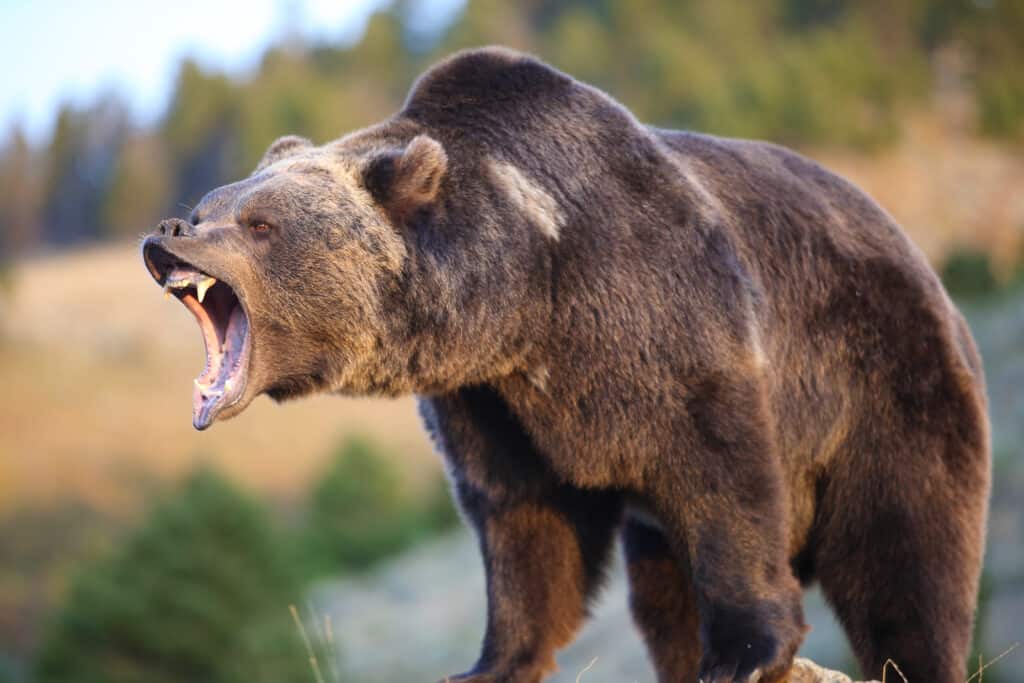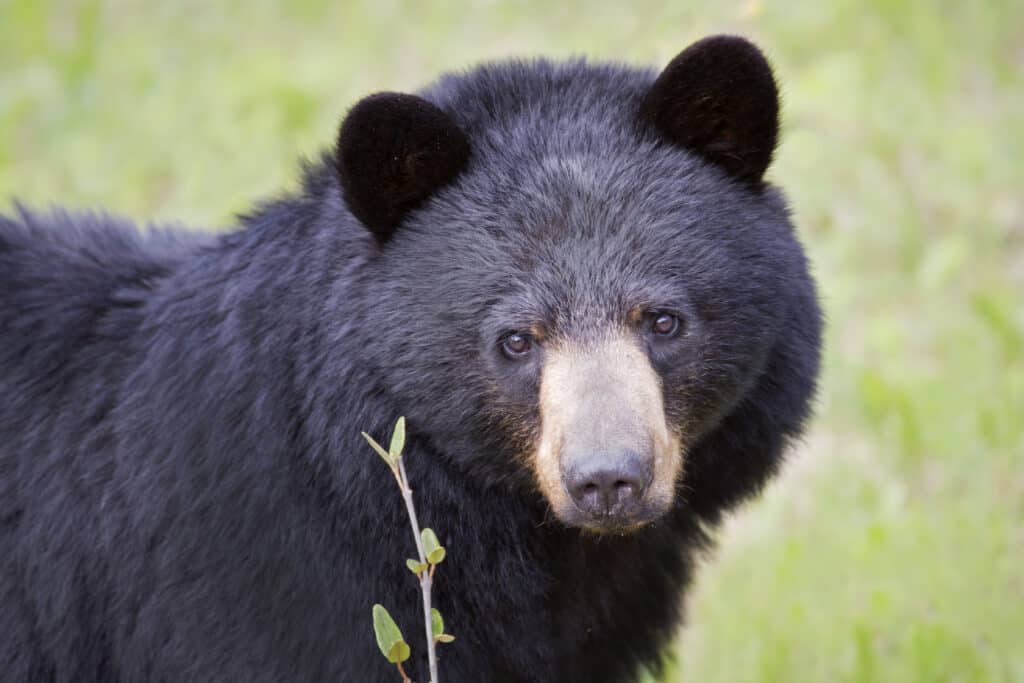Utah is a gorgeous state known for its five national parks, the Mighty Five. These parks boast a vast array of wildlife, including a healthy number of bears. The state’s flourishing bear population attracts many hunters hoping to bag a record-setting kill. Discover the largest bear ever caught in Utah!
The Largest Bear Ever Caught in Utah

A grizzly bear was the largest bear caught in Utah.
©Dennis W Donohue/Shutterstock.com
The largest bear ever caught in Utah was a grizzly bear named Old Ephraim. The adult male grizzly weighed 1,100 pounds at the time of his death and stood 10 feet tall. A sheepherder named Frank Clark began hunting him in 1914 to stop him from killing sheep, for which he was infamous. He succeeded in shooting and killing Old Ephraim on August 21, 1923. Most experts accept this as the last grizzly bear sighting in Utah, though some dispute it.
On July 1, 1975, Merrill Daniels and Alma Lund discovered the carcass of the largest black bear on record in Utah. The carcass lay about seven miles east of Ephraim. The Boone and Crockett Club lists the skull size as 23 10/16 inches. Because this measurement was more than an inch greater than the previous record, Daniels and Lund sent the skull to experts at the Smithsonian Institution in Washington, DC. They verified the species and measurement, confirming a new record.
The previous Utah record holder came from San Pete County in Utah. Rex W. Peterson and Richard Hardy killed a black bear with a skull measuring 22 6/16 inches. They held the record from 1970 to 1975.
Black Bear: Types and Appearance

The American black bear resides in Utah.
©BGSmith/Shutterstock.com
Currently, Utah is home to only one species of bear, the American black bear (Ursus americanus). Two other bear species inhabit North America, the brown bear (Ursus arctos) and the polar bear (Ursus maritimus). Two subspecies of brown bears are particularly infamous, the grizzly bear (Ursus arctos horribilis) and the Kodiak bear (Ursus arctos middendorffi). Grizzly bears may occasionally wander into Utah from Wyoming and Idaho, though they haven’t established any breeding populations within the state since their extirpation around 1923.
Black bears come in a number of different colors including black, brown, cinnamon, blond, bluish-grey, and white. White black bears (Ursus americanus kermodei), also known as spirit bears or Kermode bears, live solely in British Columbia in Canada.
Black bears are the smallest of the three North American bear species. Adult males usually weigh between 125-500 pounds while adult females average 90-175 pounds. They are heaviest in late summer and early fall when they eat almost constantly to bulk up for the lean winter months. Adults measure around 4.6 feet in length and stand 3.3-3.9 feet at the shoulder.
Black Bear: Habitat
Black bears prefer forests and mountains, though potential habitats also include shrublands, wetlands grasslands, and deserts. An adult male’s range may be as large as 15 square miles and overlap with the ranges of several females. Occasionally, the ranges of different males may overlap as well. Though most are diurnal in the wild, bears in frequent contact with humans may become nocturnal to avoid interaction.
American black bears are endemic to North America, roaming across parts of the United States, Canada, and Mexico. The bulk of their population is found in the Pacific Northwest extending into the upper Midwest, Canada, and Alaska. They also roam the Rocky and Appalachian Mountains down into the southern States and northern Mexico. Approximately 40 US states are home to black bears.
How Many Black Bears Are There in Utah?
Currently, there are approximately 4,000 black bears in Utah. They range throughout the state, though many of them reside in Zion National Park. Utah’s northern, western, and southwestern regions are particularly populous. Most black bears in the state avoid urban areas, making the conflict between bears and humans rare.
The IUCN lists black bears as Least Concern due to their increasing population across North America.
Is It Legal to Hunt Bears in Utah?
It is legal to hunt black bears in Utah with a license. Hunters may hunt in nonrestricted pursuit units during select dates in the spring (April-May), summer (July), and fall (November) seasons. In restricted units (the Book Cliffs, La Sal, and San Juan units), seasons include dates in spring (April-May), summer (early to mid-July), and late summer (mid to late July). See the Utah Division of Wildlife Resources for more information about black bear hunting in Utah, including their black bear hunting guidebook.
Are Black Bears Dangerous?

Black bears can be dangerous if provoked.
©Wild Art/Shutterstock.com
Though they prefer to avoid humans, black bears can be dangerous if cornered or provoked. Hunger motivates most attacks, which tend to occur when a foraging bear comes in contact with people. Habituated bears who live near human populations or in areas like national parks come to expect ready food sources. They may grow increasingly aggressive as they lose their natural fear of people. Never pet or feed a wild bear.
Black bear attacks are infrequent across North America, resulting in less than one fatality per year. Still, it’s wise to take precautions such as carrying bear spray and making moderate noise while hiking. Avoid surprising nearby bears or getting too close.
Conclusion
The largest bear ever caught in Utah might have been a grizzly, but today visitors and residents of the state will typically only find black bears. For the official measurements of the world’s record-setting bears, see this list.
Up Next:
- Discover the Largest Bear Ever Caught in Kentucky
- Discover the Largest Bear Ever Caught in Idaho
- Discover the Largest Bear Ever Caught in New York
- Discover the Largest Bear Ever Caught in Michigan
- Discover the 10 Largest Bears in the World
The photo featured at the top of this post is © Elizabeth Caron/Shutterstock.com
Sources
- Wide Open Spaces (1970) wideopenspaces.com/the-biggest-bears-known-to-have-walked-the-earth/
- The Salt Lake Tribune, Available here: https://archive.sltrib.com/article.php?id=4542803&itype=CMSID#:~:text=Legend%20has%20it%20that%20the,legendary%20Old%20Ephraim%20on%20Aug.
- Zion National Park, Available here: https://zionnationalpark.com/news/the-truth-about-bears-in-utah/
- National Park Service (1970) nps.gov/articles/000/american-black-bear.htm#:~:text=Black bears are common throughout,Mountains%2C and down into Mexico.
- (1970)
Thank you for reading! Have some feedback for us? Contact the AZ Animals editorial team.






